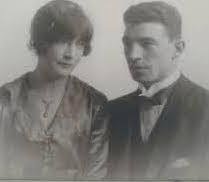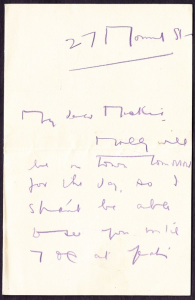
Michael Gorman is the eldest son of Michael and Susan Gorman. He was born in 1927 and lived all his life, until his marriage in 1970, in the family home at 40 Marlborough Road, Donnybrook, Dublin. He was the middle child of three, with an elder sister Joan and younger brother Gerald. Michael joined the Irish Tourist Board in 1952 and worked there in various roles until his retirement in 1972. He was the first editor of the Irish Tourist Board’s magazine Ireland of the Welcomes which lasted over fifty years and achieved a paid circulation of over 100,000 – mostly in the United States.
Michael told us about his parents’ letter collection which contains a number of letters written between 1 November 1915 and 31 October 1916.
I heard about the Letters of 1916 project from my son Michael John, who is the Director of the Science Gallery in Trinity College Dublin. The letters were passed to me a few years ago by a member of my brother Gerald’s family, who had kept them since my father’s death in 1982. As they were unsorted and hard to read, I decided to transcribe and archive them.

My parents came from very different backgrounds. He spent his early years with ten siblings, in a large thatched cottage on the family farm of Ballinalug on the northern slopes of the Slieve Bloom Mountains near Clara Hill, whilst she grew up on the other side of the mountains, in a large house called Raheenahone, near Stradbally. What made their relationship so special was the fact that she was Church of Ireland Protestant and he was Catholic. As a consequence, neither family wanted the other, and Michael and Sue had to spend half a decade meeting in secret and exchanging letters in what was a love affair that would last all their lives.
Michael Joseph Gorman was the recipient of the letters in the collection. There was a strong focus on education in his family and he entered the Albert Agricultural College in Glasnevin as a student in 1906 and was appointed to the staff of that college in 1911. By 1913, he was well integrated into Dublin social life and was a brother of the (now forgotten) Reality League. On 6 December 1913, he participated in a fancy dress party in Fuller’s Café on Grafton Street, celebrating the departure of Count Casimir Markiewicz to Poland.

By early 1916, Susan had moved to Dublin, where she trained and worked in the Royal Hospital in Baggot Street. At that time, the Royal Hospital was a military hospital caring for wounded soldiers back from the trenches in France. Sometimes their relationship seemed to be going nowhere, and in a letter sent on 23 December 1916, Susan said that they should end it and burn all their letters. She burned all Michael’s letters, but fortunately, he didn’t fulfil his part of the bargain and kept the letters he had received from her.
The Ne Temere decree of the Roman Catholic Church, which came into force in 1908 and made marriages between Roman Catholics and Protestants nearly impossible, presented a major challenge for them. They tried to marry in Dublin in 1919, but were told by the priest that they would be notified of the church at 9.30pm the night before, where the marriage would take place the following morning at 6.30am, in the sacristy, of course, so that they couldn’t invite friends and ‘give scandal’. They eventually married in Our Lady’s Queen of Victories Church in London and lived a rich and interesting life in Dublin in the years that followed.
When Sue died in 1980, Michael said ‘I feel as if I’ve lost a part of me, as if I’ve lost a limb’.
Michael has produced a book version of the complete collection of Susan’s letters to Michael under the title ‘Dearest Mickie”. If you would like to read Michael’s blog, click here.